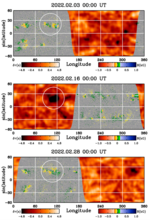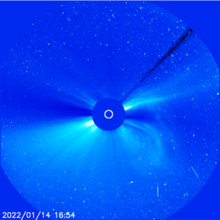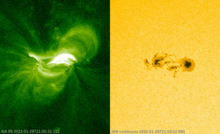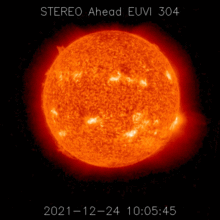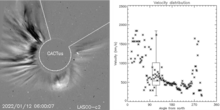news
Submitted on 2022-03-04
The Management Committee of Belspo, joins the numerous expressions of support from the Belgian and international scientific community regarding the armed conflict in Ukraine.
Submitted on 2022-03-02
Space-based observations reveal amazing features of the spectacular far-side solar eruption that occurred on 15 February.
Submitted on 2022-02-23
The STCE's SC25 Tracking page has been updated to reflect the latest evolution in solar and space weather activity. Solar cycle 25 seems to be heading for a maximum that is a bit higher than originally predicted.
Submitted on 2022-02-15
Following a minor geomagnetic storm on 3 and 4 February, 40 Starlink satellites got lost. A number of these have already burned up in the earth's atmosphere.
Submitted on 2022-02-09
Sunspot region NOAA 2936 dominated the solar activity during the last 2 weeks. It was one of the largest sunspot groups so far this solar cycle, and produced more than 50 C-class flares.
Submitted on 2022-02-02
For a spacecraft designed to conduct unique studies of the Sun, Solar Orbiter is also making a name for itself exploring comets.
Submitted on 2022-02-01
Despite the many cloudy days last month, solar telescopes at the ROB were able to capture a nice filament eruption on 14 January. Also the big sunspot group NOAA 2936 did not escape the instruments' vigilance.
Submitted on 2022-01-25
On 24 and 25 December last year, the Sun happily surprized solar observers with a wonderful Christmas gift in the form of an impressive solar eruption. Solar Orbiter's Full Sun Imager was on the right place to capture this mesmerizing event.
Submitted on 2022-01-18
An active region that produced several C-class flares and even an M-class flare while it was still behind the solar limb, turned out to be a very small sunspot group and did not produce any significant flaring once it became visible on the solar disk.
Submitted on 2022-01-17
Tickets for the 4th Symposium on Space Educational Activities are available at a discounted early-bird price until January 31st! Hurry up and do not miss the opportunity to discuss with outreach experts from all over the world.
Pages
Zircon - This is a contributing Drupal Theme
Design by
WeebPal.





